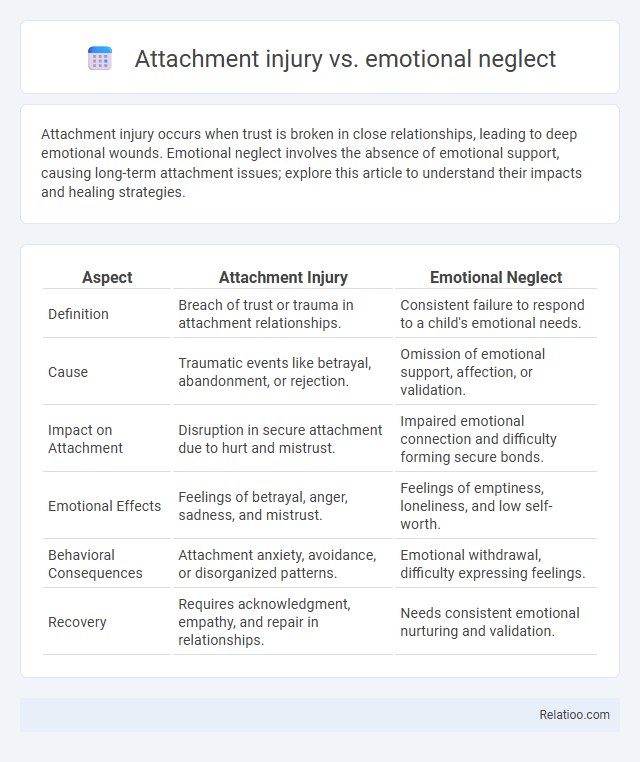Attachment injury occurs when trust is broken in close relationships, leading to deep emotional wounds. Emotional neglect involves the absence of emotional support, causing long-term attachment issues; explore this article to understand their impacts and healing strategies.
Table of Comparison
| Aspect | Attachment Injury | Emotional Neglect |
|---|---|---|
| Definition | Breach of trust or trauma in attachment relationships. | Consistent failure to respond to a child's emotional needs. |
| Cause | Traumatic events like betrayal, abandonment, or rejection. | Omission of emotional support, affection, or validation. |
| Impact on Attachment | Disruption in secure attachment due to hurt and mistrust. | Impaired emotional connection and difficulty forming secure bonds. |
| Emotional Effects | Feelings of betrayal, anger, sadness, and mistrust. | Feelings of emptiness, loneliness, and low self-worth. |
| Behavioral Consequences | Attachment anxiety, avoidance, or disorganized patterns. | Emotional withdrawal, difficulty expressing feelings. |
| Recovery | Requires acknowledgment, empathy, and repair in relationships. | Needs consistent emotional nurturing and validation. |
Understanding Attachment Injury: A Brief Overview
Attachment injury refers to the deep emotional wounds caused by a breach of trust or neglect in early caregiver relationships, resulting in difficulties forming secure bonds. Emotional neglect involves the consistent failure to meet a child's emotional needs, which can lead to attachment injuries and impaired emotional development. Understanding attachment injury is crucial for recognizing how early relational trauma affects adult attachment patterns and mental health.
Defining Emotional Neglect in Relationships
Emotional neglect in relationships refers to the consistent failure to respond to a partner's emotional needs, leading to feelings of invisibility and disconnection. Unlike attachment injury, which involves specific breaches of trust or betrayal cutting emotional bonds, emotional neglect is characterized by the ongoing absence of emotional support and validation. This persistent lack of emotional engagement disrupts healthy attachment patterns and can cause long-term relational damage.
Key Differences Between Attachment Injury and Emotional Neglect
Attachment injury involves specific events where a significant breach of trust occurs between an individual and their caregiver, often marked by betrayal or abandonment, whereas emotional neglect refers to a consistent lack of emotional responsiveness or support over time. Key differences lie in the immediacy and specificity of the trauma in attachment injury compared to the chronic absence of emotional care in emotional neglect. Understanding these distinctions helps you identify whether healing efforts should target particular relationship ruptures or broader patterns of unmet emotional needs.
Common Causes of Attachment Injuries
Attachment injuries often stem from betrayal or disruption in caregiver relationships, such as unresponsive parenting or trauma, while emotional neglect arises from consistent emotional unavailability or lack of validation by caregivers. Common causes of attachment injuries include abandonment, rejection, and inconsistency in caregiving, leading to trust issues and emotional dysregulation. Emotional neglect frequently results from caregivers' failure to provide necessary emotional support, fostering feelings of worthlessness and insecurity in the child.
Typical Scenarios Leading to Emotional Neglect
Typical scenarios leading to emotional neglect often involve caregivers consistently failing to respond to a child's emotional needs, such as ignoring signs of distress, lacking warmth or affection, and not validating the child's feelings. In contrast, attachment injury occurs when a significant breach of trust or safety happens in the caregiver-child relationship, like abandonment or betrayal, causing severe relational trauma. Emotional neglect primarily results from ongoing absence or insufficient emotional responsiveness, distinct from the acute relational trauma characteristic of attachment injury.
Psychological Symptoms of Attachment Injury
Attachment injury often results in intense psychological symptoms such as mistrust, anxiety, and emotional dysregulation, distinguishing it from emotional neglect, which primarily causes feelings of emptiness and low self-worth. Your emotional responses in attachment injury are typically rooted in specific breaches of trust or traumatic relational events, leading to difficulties in forming secure bonds. Understanding these symptoms is crucial for targeted therapeutic interventions addressing the deep emotional wounds caused by attachment injury.
Long-Term Effects of Emotional Neglect
Long-term effects of emotional neglect often include difficulties in forming secure attachments and impaired emotional regulation, which can lead to chronic feelings of loneliness and low self-esteem. Unlike attachment injury, which typically results from a specific breach of trust in a close relationship, emotional neglect is characterized by a persistent absence of emotional support during critical developmental periods. Understanding how emotional neglect impacts your mental health is essential for targeted therapeutic interventions and healing.
Healing and Recovering from Attachment Injuries
Healing from attachment injuries involves rebuilding trust and emotional safety through consistent, empathetic interactions that validate your feelings and experiences. Emotional neglect recovery focuses on recognizing unmet needs and fostering self-compassion while developing healthy emotional expression and boundaries. Addressing attachment injuries requires therapeutic approaches like trauma-informed therapy or attachment-based counseling to repair relational patterns and support long-term emotional resilience.
Rebuilding Trust After Emotional Neglect
Attachment injury occurs when trust is broken due to betrayal or abandonment, while emotional neglect involves consistent unresponsiveness that hinders secure attachment formation. Rebuilding trust after emotional neglect requires consistent, empathetic communication and creating a safe environment that validates feelings and fosters emotional connection. Therapeutic interventions often focus on repairing internal working models and enhancing emotional attunement to restore relational security.
When to Seek Professional Help for Deep Emotional Wounds
Seek professional help for deep emotional wounds when persistent feelings of insecurity, anxiety, or difficulty forming trusting relationships interfere with daily functioning, as seen in attachment injuries or emotional neglect. Therapeutic intervention becomes crucial if coping mechanisms fail to alleviate symptoms such as chronic sadness, emotional numbing, or recurring trauma responses. Early support from mental health professionals facilitates healing by addressing the root causes intrinsic to attachment injuries and sustained emotional neglect.

Infographic: Attachment injury vs emotional neglect
 relatioo.com
relatioo.com